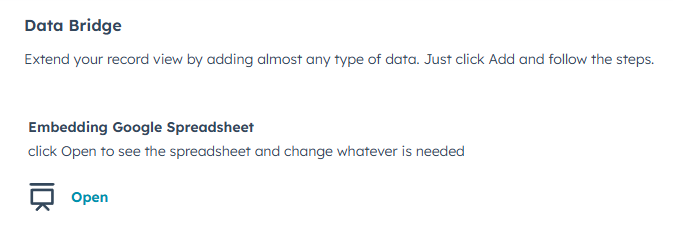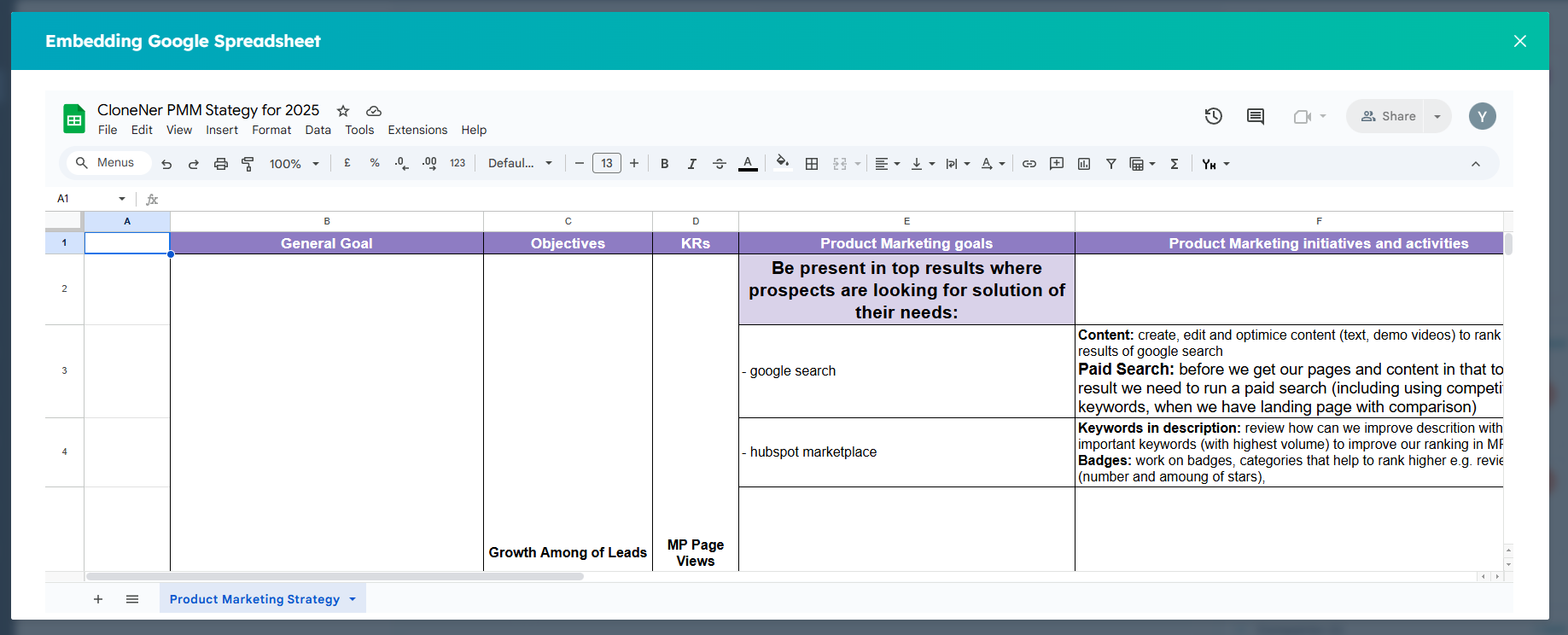Check out our Video guide about how to embed your first Google Spreadsheet!
HubSpot is one of the most popular CRMs for sales, marketing, and customer success teams. It centralizes communication, pipelines, and reporting. Yet, if you’ve worked in HubSpot for some time, you’ve probably noticed a limitation: not all the data your team relies on can live inside CRM properties. Many businesses depend heavily on Google Sheets for calculations, client reporting, and tracking processes that don’t neatly fit into HubSpot fields.
The question arises: can you put Google Spreadsheets directly into HubSpot records, such as deals, companies, or contacts? The short answer is that HubSpot doesn’t support this natively. But there is a practical solution, and it can significantly reduce friction in your daily workflows.
Why Google Sheets Still Matter in a HubSpot-Centric World
Google Sheets continues to be the “catch-all” tool for flexible data management. Even with HubSpot handling core CRM data, many teams maintain spreadsheets for tasks like:
-
Advanced pricing models or profitability calculators that don’t fit neatly into HubSpot’s line items.
-
Project trackers where multiple stakeholders update progress in real time.
-
Client-specific reports and metrics that are updated outside the CRM.
-
Team quota, forecasting, or scheduling sheets are used by leadership and operations.
These spreadsheets are valuable because they remain easy to update, collaborative, and accessible. But the problem is that they live outside HubSpot. Every time someone needs to check or update the data, they leave the CRM, dig through Google Drive, or search for a link in Slack or email.
Over time, this back-and-forth not only wastes time but also introduces errors. Different versions of the file may circulate. Team members may forget to check for updates. And most importantly, the data is disconnected from the records where it matters most — deals, companies, and contacts.
The Problem with Common Workarounds
If you browse through HubSpot Community forums, you’ll see that many users have asked about embedding Google Sheets. The answers usually point to workarounds:
-
Links in notes or custom properties. These let you store a shortcut, but they send users outside of HubSpot and break the workflow.
-
Attachments. Uploading a spreadsheet file into a record seems convenient, but the file becomes static. As soon as the sheet is updated in Google Drive, your HubSpot copy is already outdated.
-
Dashboards. HubSpot dashboards do allow embedding external content like Google Sheets, but dashboards are not tied to individual records. They serve reporting purposes, not the record-level context teams usually need.
Each workaround solves part of the problem, but not the whole thing. What teams are looking for is a live spreadsheet view inside a record, one that updates automatically and is visible in the same place where the team is already working.
How Data Bridge Solves the Gap
This is exactly the gap that Data Bridge for HubSpot fills. The app was built to embed external content - including Google Spreadsheets - into HubSpot records in a clean, seamless way.
- Install and add the Data Bridge card.

- Fill in the Label, Priority, and choose where this spreadsheet should appear.
- Paste the link to the Google Spreadsheet.

- Check the preview and click Submit.

From that moment, the spreadsheet is visible inside HubSpot, always live, always up to date. Anytime you can click Open and make changes.

For HubSpot Professional users, Data Bridge goes a step further. Instead of just showing spreadsheets in the Overview card, you can add them as a separate tab next to “Overview” and “Activities.” This makes navigation cleaner and ensures that detailed spreadsheets don’t clutter the main record view but remain instantly accessible when needed.
What This Looks Like in Practice
Embedding spreadsheets directly into records can transform the way different teams work in HubSpot.
-
Sales reps no longer jump between Google Drive and HubSpot to check profitability. Instead, a calculator sheet appears inside the deal.
-
Customer success managers can track onboarding or project progress directly in the company records. Every update in the Google Sheet instantly reflects in HubSpot.
-
Marketing teams can keep campaign budget sheets inside contact or deal records, ensuring account managers always see the latest numbers.
-
Operations and RevOps can store territory or forecasting spreadsheets at the record level, so leadership has immediate visibility without exporting data.
These scenarios show how embedding spreadsheets isn’t just a nice extra, it directly supports faster decision-making, reduces miscommunication, and keeps data consistent.
Why Live Embedding Matters
The key advantage of using Data Bridge over traditional workarounds is real-time updates. A link or attachment requires users to open a separate file or risks becoming outdated. But when you embed a spreadsheet, you’re displaying the actual live version. Any change made in Google Sheets - whether by sales, finance, or operations - appears immediately in HubSpot.
This saves time and ensures everyone is aligned. No more emailing updated files or wondering which version is the latest. The HubSpot record becomes the single place where all relevant information, internal or external, comes together.
Bringing It All Together
If you’ve ever tried to figure out how to embed Google Spreadsheets into HubSpot records, you already know it’s not possible with HubSpot alone. Workarounds like links, attachments, and dashboards only go so far and don’t solve the problem at the record level.
With Data Bridge, embedding spreadsheets becomes straightforward. Whether you’re displaying deal calculators, project trackers, or client reports, the sheet stays live, up to date, and visible directly in HubSpot. For Professional plan users, the option of placing spreadsheets in a dedicated tab makes the experience even smoother.
The result is a CRM that works closer to how your team actually operates, one place for communication, context, and data. Instead of juggling tools, everything you need to make decisions and serve customers is in front of you.
You can sign up for the Data Bridge Beta test via the Contact Us Form and start embedding your spreadsheets today.





.png)
.png)